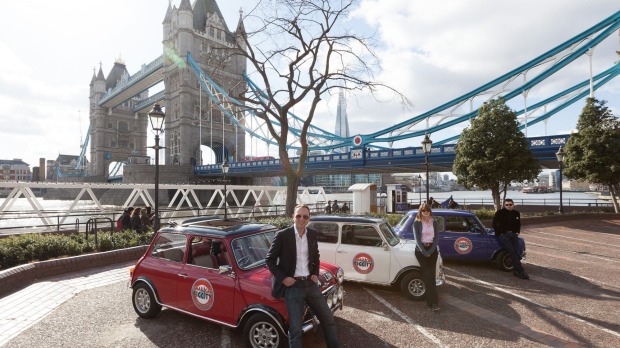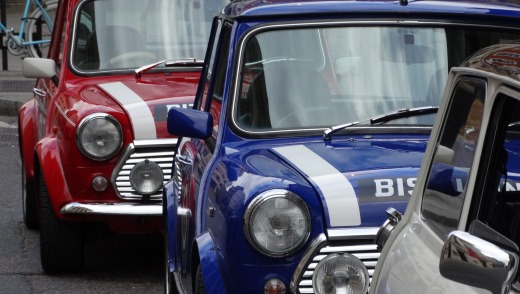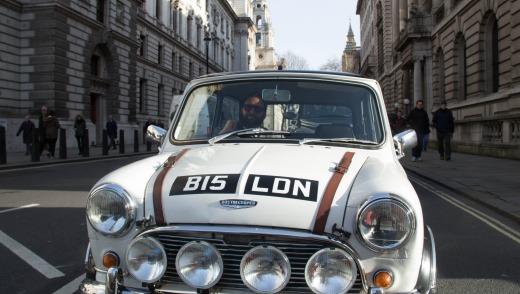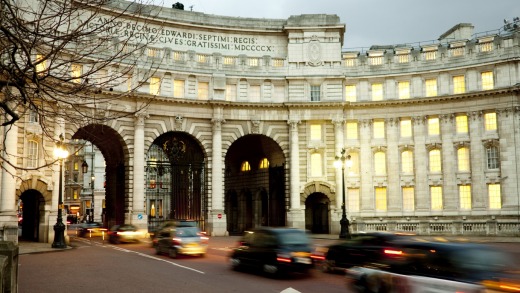
Nothing is more likely to stir an Englishman's blood than the words "you're only supposed to blow the bloody doors off", delivered in an unmistakable London accent by actor Michael Caine.
Taken from the cult 1969 gold heist film The Italian Job, the lines have been voted the most memorable lines in a British film ever, were referenced in the closing ceremony of the London Olympics, and are uppermost in my mind when we find four gleaming Mini Coopers parked at the kerb outside our hotel in Westminster.
We aren't there to blow stuff up, sadly, but racing around London in a quartet of vintage Mini Coopers – the cars featured so famously in the amazing car chase scenes through Turin in the movie – is surely the next best thing.

The cars and the drivers-cum-guides belong to an outfit called Small Cars Big City, which launched in 2009 to provide sightseeing tours around London in restored Mini Coopers.
Quite apart from its popularity in the film, the Mini has always had a place in the hearts of the British. The first Minis came off the production line in 1959, by 1962 sales were up to half a million and the car soon became synonymous with London and the Swinging Sixties. By the year 2000, some 5.3 million had been sold worldwide.
It's a love affair that shows no signs of abating if the smiles and admiring looks our convoy gets are anything to go by.

On the Small Car Big City website they boast about providing tours for people who dislike tours – and they certainly live up to it with drivers who are chatty, knowledgeable and full of lesser-known facts and yarns about the capital.
In our 90-minute scoot from Westminster through west London then down south of the river and on to Greenwich one of our first stops is in Mayfair's leafy Berkeley Square, of singing nightingale fame and the fictional home of Bertie Wooster.
But it's not these that interest Howard, our driver. Instead, he points to the building at 50 Berkeley Square where one of English Heritage's famous blue plaques reports "George Canning (1770-1827), Statesman, lived here".

Canning himself is known for having the shortest tenure of any British prime minister, dying in harness just four months after taking the job in 1827. But it's not Canning we're interested in; it's his house, which is said to be the most haunted house in London.
Several people have killed themselves or died after spending a night there, says Howard, and legend has it that the ghost is of a young woman who threw herself from the top floors after being abused by her uncle and who now returns as a spooky brown mist.
And as we pass under Admiralty Arch, the grand Edwardian pile that links Trafalgar Square with Pall Mall, Howard points to a disembodied gold nose positioned just over two metres up the wall on the northernmost arch. It is, he explains, a gold replica of the Duke of Wellington's snozzer, positioned there so that a man on horseback can see it easily.
We also learn about the penis shapes that the shamrock-shaped holes on the balustrade of Westminster Bridge throw on the pavement on sunny days, discover why Green Park has no flowers, blush at what happened in the posh Burlington Arcade when it was a red light district, and find out why Pall Mall and Piccadilly are so called.
Then, after a thrilling shortcut down a narrow street and under a building which brought back memories of the Minis racing through tunnels in Turin in the movie, we emerge next to the Thames and Howard drops his bombshell: one of the facts he's told us today is a hoax. But which one*?
Small Cars Big City also run an Italian Job-themed scavenger hunt in which teams, dressed in overalls from the movie, compete to find secret corners of the city. And, no, you don't get to blow any bloody doors off.
*The nose on Admiralty Arch was put there anonymously in 1997 by artist Rick Buckley as a comment on Big Brother society. Prior to his unmasking in 2011, an urban myth grew that the nose was there to honour Wellington, who was known for his large proboscis.
See smallcarbigcity.com.